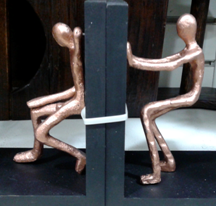Thank you Fallout Boy for reminding me of another plot structure. Consecutive stories in parallel narratives are one of the special ingredients in Pulp Fiction directed by Quentin Tarantino. Granted, there is plenty to love or hate about the film. Before I first watched Pulp Fiction, I knew people who had left mid-show because of the graphic scenes. I also knew cinematography buffs, who quoted the film verbatim. For this post, I ask you to consider only the story structure and to forget about Uma Thurman dancing, the drugs, the language and the violence.
Deceiving and confusing for a majority of the movie, Pulp Fiction keeps the audience off-balance with a scrambled time sequence. The first two scenes escalate to a moment of high tension and then abruptly end. In the opening diner scene, Tarantino pauses the action at a point where guns are drawn and a robbery is in progress. The film leaps to an unrelated scene with Vincent Vega and Jules Winnfield driving to Brett’s apartment. In the middle of the apartment scene, the film shifts ahead to follow Vincent Vega, the main character of the first of three consecutive stories.
After the third story concludes, the diner scene comes into perspective as a book-end, both a prologue and an epilogue to the three plots in Pulp Fiction. On her website, Linda Aronson describes this structure as a portmanteau or bag structure, one story that contains the other stories.
Titles in the movie provide a swift transition from one story to the next. The first story is Vincent Vega and Marsellus Wallace’s Wife. The Gold Watch is Butch Collidge’s object story; a flashback shows the receipt of his father’s important watch. The Bonnie Situation is Jules Winnfield’s revelation story. The order is not chronological because Pulp Fiction employs a fractured frame portmanteau, one story split to bookend the other stories within a shifted time frame. I confess to mapping the time sequence on a notepad only after erasing half a dozens times and marking shifts with arrows, numbers and letters. Consider the scenes below. The number bullets show the films order. The alphabet bullets reveal the true chronological order. Not every scene is on my list—only the scenes with time shifts.
Film Order (1-9) / Chronological Order (A-J)
1D) DINER SCENE Honey Bunny and Pumpkin
——-Vincent Vega and Marsellus Wallace’s Wife——
2B) VINCENT and Jules in Brett’s APARTMENT SCENE
3F) Marsellus tells BUTCH to lose the fight and VINCENT to escort wife
——The Gold Watch——
4A) BUTCH receives watch FLASHBACK
5G) BUTCH returns for watch / shoots Vincent
——The Bonnie Situation——
6C) JULES miracle in Brett’s APARTMENT SCENE with Vincent
7E) DINER SCENE JULES, Vincent and Pumpkin
The intersection of the plots gives the viewer only a few hints to order the scenes. The initial scene with Honey Bunny and Pumpkin’s robbery-in-action hooks the viewer at the beginning of the film, but chronologically, this scene is in the middle of the movie. “The Bonnie Situation” occurs before the diner scene but is shown at the end of the film. In the Gold Watch, Butch Coolidge shoots Vincent. The movie, however, leapfrogs backward in time to show Vincent alive with Jules in “The Bonnie Situation.” Jules’ words foreshadow Vincent’s fate. The viewer knows of Vincent’s coming death because it has already played in the out-of-order time continuum. Sound confusing? It is.
This film’s fractured frame provides a building of the plot’s violent intensity. After Bret’s apartment, the film departs to lighter topics before coming back to the most graphic scene in “The Bonnie Situation.” Perhaps my word choice of lighter topics sounds absurd for scenes containing a drug overdose, a brawl to near death and sexual bondage. In this film, however, greater incidents of violence lead to greater examples of hope—resurrection from death, rescue of an enemy, and repentance—in Tarantino’s portrayal of darkness or nihilism. Both the cause and consequences are plot.
Wow! You really know how to analyze a movie. I’ll have to see it again now that you’ve clarified the portmanteau.
Thanks Barbara. Let me know what you think.
I salute you for spending the time to deconstruct the film. It’s very interesting. I wonder, like Kelly does, how this would play out in book form.
Hi Sue, to add to my comment to Kelly, we see time disruptions, but in print the shift is more subtle, like a flashback or story within a story. I have a post planned for a piece by author Robert A. Heinlein that will illustrate. Hmm, I just have to write it.
Hi, Karen. Perhaps if I were studying the film for its structure, I would have appreciated it more than I did. I wonder if readers would tolerate such a confusing plot in book form. What do you think?
Hi Kelly, the bag, or portmanteau, is common with a storyteller or narrator at the beginning and ending. The fractured time frame is represented too. I see more now than in my earlier reading—could be my current choice of authors or more in general.
Interesting story structure. Article well written, thought and planned.
Thanks Jacqui. Maybe now I can stop humming that tune—nope, not yet.
Thanks Diana. I agree on the translation issue. Although in this example, I’m awed by Tarantino and Roger Avary’s screenplay. They accomplished their goal of Elmore Leonard-like dialogue.
As a college film major, I always appreciate the study of story and structure. There can be a difference in translation between the scriptwriter and the director’s vision. As a woman who enjoyed the cult classic and sought after Vamp for my nails, this is an interesting breakdown and interpretation. A writer can gain a lot from quirky and popular films, but they need to know what to look for. Your post helps.